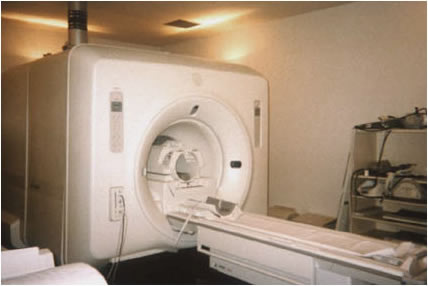 Is there any radiation exposure during ultrasound exams or magnetic resonance imaging (MRI)? Is there any radiation exposure during ultrasound exams or magnetic resonance imaging (MRI)?
 Ionizing radiation is not used in either ultrasound exams or magnetic resonance imaging (MRI). Thus, these procedures do not involve exposure to radiation. Ionizing radiation is not used in either ultrasound exams or magnetic resonance imaging (MRI). Thus, these procedures do not involve exposure to radiation.
Magnetic resonance imaging (MRI)

Photo provided by Nagasaki University Hospita |
The range of sound frequencies that are audible to the human ear is from approximately 16 to 16,000 Hz. Sound waves that exceed this range and cannot be heard by humans are called ultrasonic waves. An ultrasound test uses ultrasonic waves that range from a frequency of 1 mHz to 10 mHz, where 1 mHz equals 1 million Hz.
Magnetic resonance imaging (MRI) uses strong magnetism and electromagnetic waves. The strength of the magnets used ranges from the low power of magnets used in the treatment of stiff shoulders to that of up to approximately 10 times stronger. Electromagnetic waves are the radio waves used in TV and radio transmissions. The area where there is an attraction between a magnet and electricity is called a magnetic field, and this magnetic field changes dramatically during testing, but the field itself is within the standards that have been set as safe for humans.
In addition, significant noise during the MRI procedure is also generated, and ear plugs are used to prevent damage to hearing and other ill effects.
In general, people who have a pacemaker, implanted hearing devices or cerebral aneurysm clips (magnetic metallic objects) cannot undergo an MRI. However, many of the cerebral aneurysm clips available today do not cause problems during an MRI. Please consult a radiologist for further information.
Cheked by Kuniaki Hayashi M.D. Professor Nagasaki University Graduate School of Biomedical Sciences
Cheked by Yutaka Okumura Professor Nagasaki Atomic Bomb Disease Institute Nagasaki University Graduate School of Biomedical Sciences
Written by Makoto Ochi M.D. Associate Professor Nagasaki University School of Medicine
|

